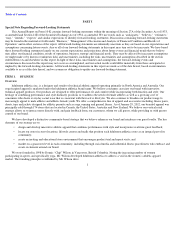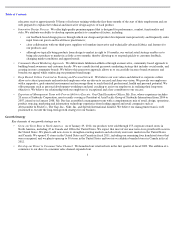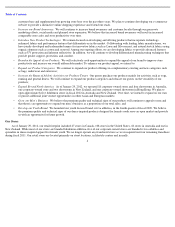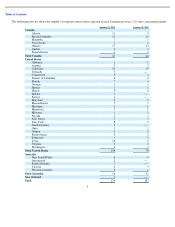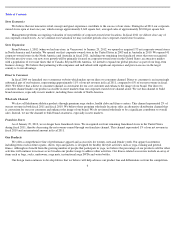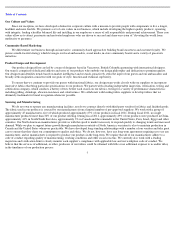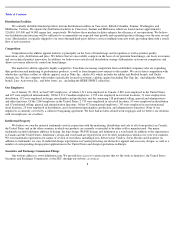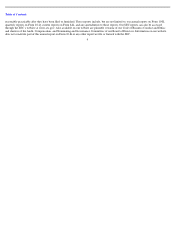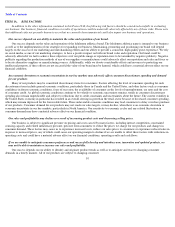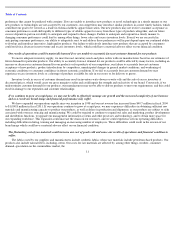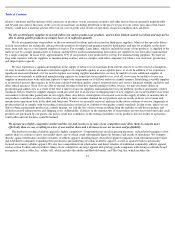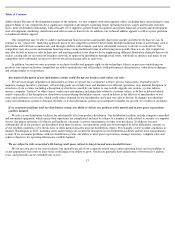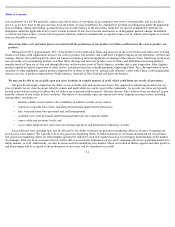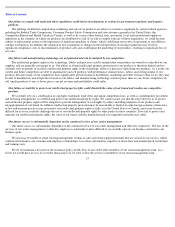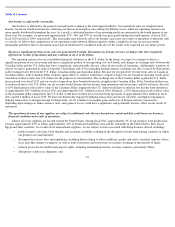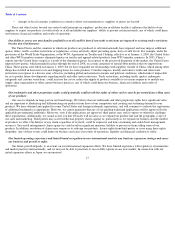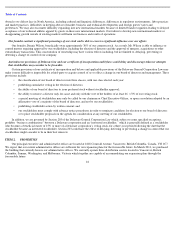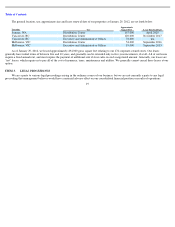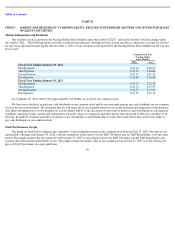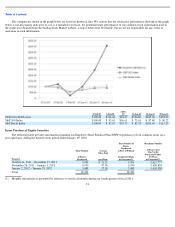Lululemon 2011 Annual Report Download - page 14
Download and view the complete annual report
Please find page 14 of the 2011 Lululemon annual report below. You can navigate through the pages in the report by either clicking on the pages listed below, or by using the keyword search tool below to find specific information within the annual report.
Table of Contents
preferences that cannot be predicted with certainty. If we are unable to introduce new products or novel technologies in a timely manner or our
new products or technologies are not accepted by our customers, our competitors may introduce similar products in a more timely fashion, which
could hurt our goal to be viewed as a leader in technical athletic apparel innovation. Our new products may not receive consumer acceptance as
consumer preferences could shift rapidly to different types of athletic apparel or away from these types of products altogether, and our future
success depends in part on our ability to anticipate and respond to these changes. Failure to anticipate and respond in a timely manner to
changing consumer preferences could lead to, among other things, lower sales and excess inventory levels. Even if we are successful in
anticipating consumer preferences, our ability to adequately react to and address those preferences will in part depend upon our continued ability
to develop and introduce innovative, high-quality products. Our failure to effectively introduce new products that are accepted by consumers
could result in a decrease in net revenue and excess inventory levels, which could have a material adverse effect on our financial condition.
Our results of operations could be materially harmed if we are unable to accurately forecast customer demand for our products.
To ensure adequate inventory supply, we must forecast inventory needs and place orders with our manufacturers based on our estimates of
future demand for particular products. Our ability to accurately forecast demand for our products could be affected by many factors, including an
increase or decrease in customer demand for our products or for products of our competitors, our failure to accurately forecast customer
acceptance of new products, product introductions by competitors, unanticipated changes in general market conditions, and weakening of
economic conditions or consumer confidence in future economic conditions. If we fail to accurately forecast customer demand we may
experience excess inventory levels or a shortage of products available for sale in our stores or for delivery to guests.
Inventory levels in excess of customer demand may result in inventory write-downs or write-offs and the sale of excess inventory at
discounted prices, which would cause our gross margin to suffer and could impair the strength and exclusivity of our brand. Conversely, if we
underestimate customer demand for our products, our manufacturers may not be able to deliver products to meet our requirements, and this could
result in damage to our reputation and customer relationships.
If we continue to grow at a rapid pace, we may not be able to effectively manage our growth and the increased complexity of our business
and as a result our brand image and financial performance may suffer.
We have expanded our operations rapidly since our inception in 1998 and our net revenue has increased from $40.7 million in fiscal 2004
to $1,000.8 million in fiscal 2011. If our operations continue to grow at a rapid pace, we may experience difficulties in obtaining sufficient raw
materials and manufacturing capacity to produce our products, as well as delays in production and shipments, as our products are subject to risks
associated with overseas sourcing and manufacturing. We could be required to continue to expand our sales and marketing, product development
and distribution functions, to upgrade our management information systems and other processes and technology, and to obtain more space for
our expanding workforce. This expansion could increase the strain on our resources, and we could experience serious operating difficulties,
including difficulties in hiring, training and managing an increasing number of employees. These difficulties could result in the erosion of our
brand image which could have a material adverse effect on our financial condition.
The fluctuating cost of raw materials could increase our cost of goods sold and cause our results of operations and financial condition to
suffer.
The fabrics used by our suppliers and manufacturers include synthetic fabrics whose raw materials include petroleum-based products. Our
products also include natural fibers, including cotton. Our costs for raw materials are affected by, among other things, weather, consumer
demand, speculation on the commodities market, the
11


